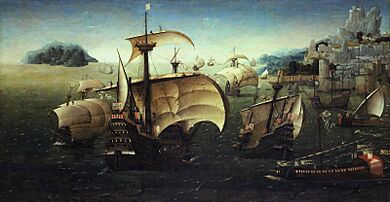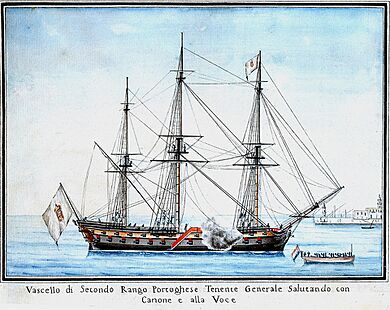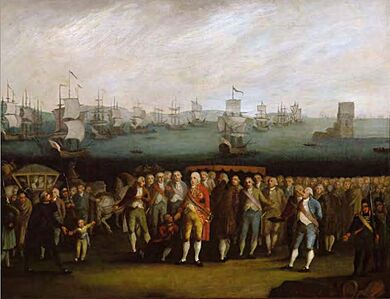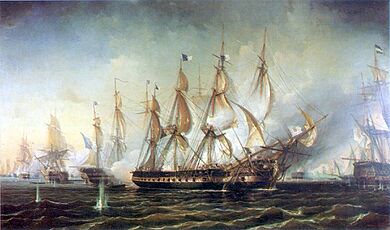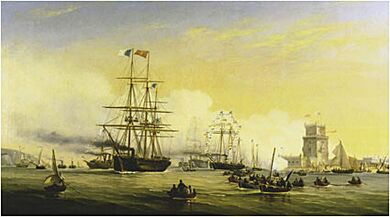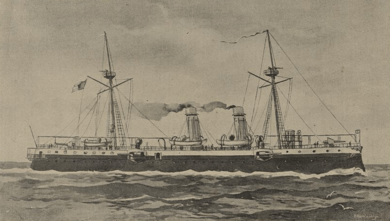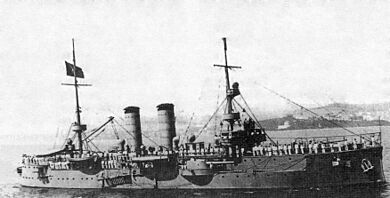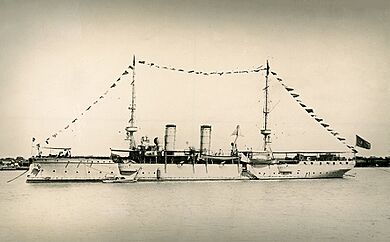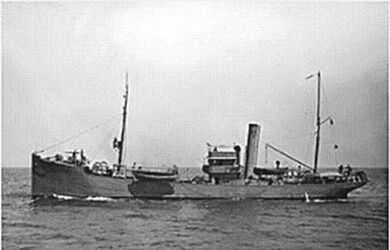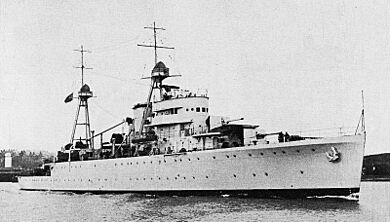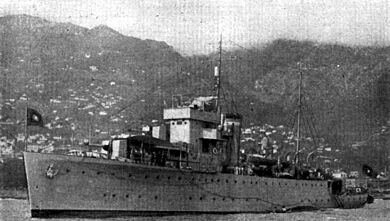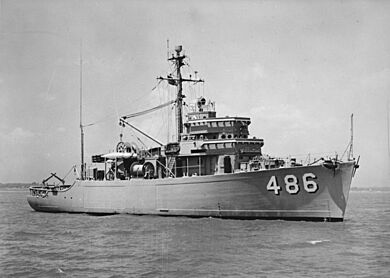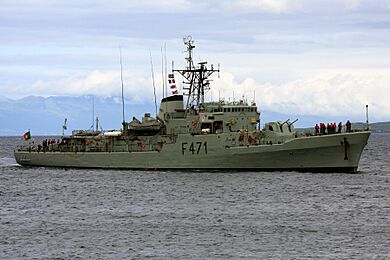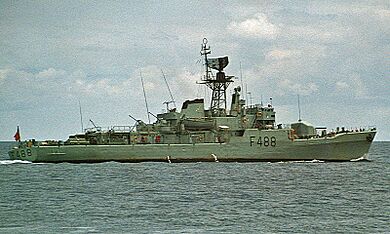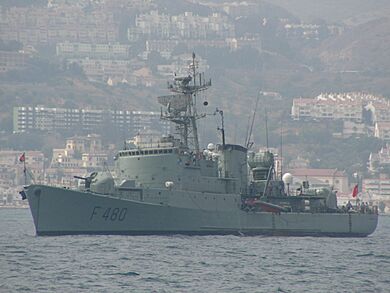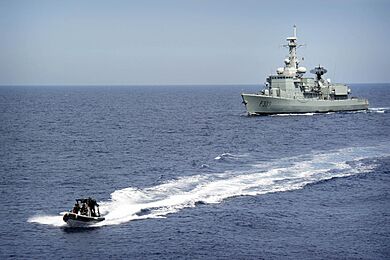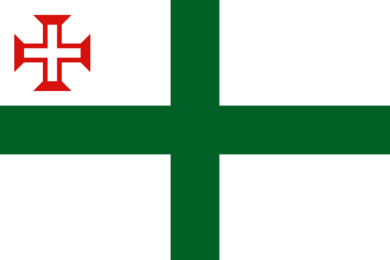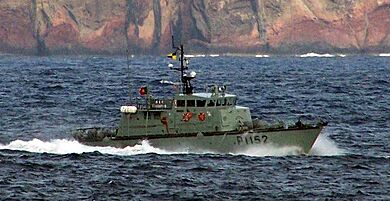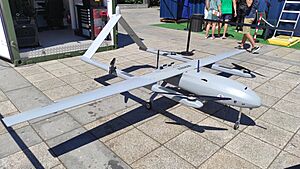Portuguese Navy facts for kids
Quick facts for kids Portuguese Navy |
|
|---|---|
| Marinha Portuguesa | |
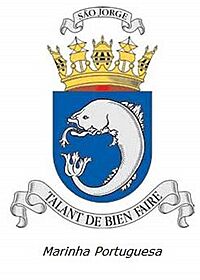
Coat of arms of the Portuguese Navy
|
|
| Founded | 1317 |
| Country | |
| Type | Navy |
| Size | 8,200 military 620 paramilitary 79 ships 5 aircraft units |
| Part of | Portuguese Armed Forces |
| Headquarters | Alfeite Naval Base, Lisbon |
| Patron | Henry the Navigator |
| Motto(s) |
|
| Anniversaries |
|
| Website | https://www.marinha.pt/pt |
| Commanders | |
| Chief of Staff | |
| Insignia | |
| Ensign | 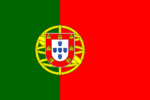 |
| Pennant | |
| Jack | 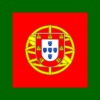 |
The Portuguese Navy (Marinha Portuguesa) is Portugal's main naval force. It is also known as the Portuguese War Navy or the Portuguese Armada. King Dinis of Portugal officially created it in 1317. This makes it the oldest navy in the world that has been serving continuously. In 2017, the Portuguese Navy celebrated its 700th birthday.
This navy was super important during the Age of Discovery in the 15th and 16th centuries. Portuguese sailors and ships explored many new parts of the world. They invented advanced ships like the caravel and the galleon. These ships helped them find sea routes to the East and to North and South America.
Famous explorers like Bartolomeu Dias sailed around Africa. Vasco da Gama reached India, connecting Europe and Asia by sea for the first time. Pedro Álvares Cabral discovered Brazil. These voyages linked Europe, Africa, and the Americas. Portuguese sailors also helped other European navies with their skills. For example, Ferdinand Magellan's crew completed the first trip around the world.
From the late 1400s to the late 1500s, the Portuguese Navy was one of the strongest in the world. Its ships and technology were top-notch. They controlled much of the Atlantic and Indian Oceans.
Today, the Portuguese Navy has two main jobs. It protects Portugal's waters and helps with international duties. It also acts as a coast guard, keeping watch over Portugal's seas. The Navy also takes part in missions with allies like NATO.
Contents
- History of the Portuguese Navy
- Early Naval Battles
- The Age of Exploration
- The Habsburg Dynasty
- Portuguese Restoration War
- The 18th Century Navy
- Napoleonic Wars and Early 19th Century
- Portuguese Civil War
- Late 19th Century to World War I
- World War I
- Between the World Wars
- World War II
- Early Cold War Era
- The Overseas Wars
- Decolonization and Late Cold War
- Activities Since 1990
- Organization of the Navy
- Culture and Music
- National Maritime Authority
- Ships and Aircraft of the Portuguese Navy
- Ranks and Insignia
- See also
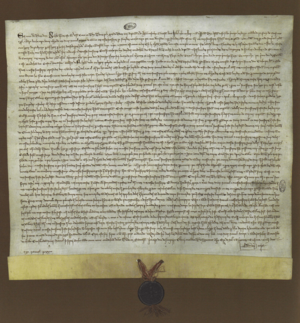
The first known naval battle involving Portugal happened in 1180. King Afonso I was ruling at the time. A Portuguese fleet, led by Fuas Roupinho, defeated a Muslim fleet near Cape Espichel. Fuas Roupinho also tried to conquer Ceuta twice.
In the 1200s, Portuguese naval forces helped capture several coastal towns from the Moors. These included Alcácer do Sal and Faro. The navy also fought against Castile and joined other Christian fleets against Muslims.
King Denis made the navy a permanent force. He appointed Manuel Pessanha as the first Admiral of the Kingdom on December 12, 1317. This date is seen as the official start of the Portuguese Navy.
In 1321, the Portuguese Navy attacked Muslim ports in North Africa. Portugal also started maritime insurance in 1323. Between 1336 and 1341, they tried to explore the seas. King Afonso IV supported an expedition to the Canary Islands.
During the 1383–85 Crisis, the Portuguese Navy played a big part in the war against Castile. A naval campaign in Galicia led to the capture of towns like Baiona. It also destroyed the naval base of Ferrol. In July 1384, the Portuguese Navy broke the Castilian siege of Lisbon. They supplied the city by defeating the Castilian Navy in the Tagus River battle.
The Age of Exploration

At the start of the 15th century, Portugal was peaceful and stable. Other European countries were busy with wars. This allowed Portugal to be the first to explore the Atlantic methodically.
Portuguese exploration in the 15th century included:
- Expanding into Morocco.
- Mapping the African coast and Canary Islands.
- Studying the Atlantic Ocean's currents and weather.
- Developing new sailing techniques.
The expansion began with the conquest of Ceuta in Morocco in 1415. Exploration of the west African coast started in 1412. It ended with the crossing of the Cape of Good Hope in 1488.
After returning from Ceuta, Henry the navigator founded a navigation school in Sagres. The main ship used was the caravel, a small, fast sailing ship. Soon, Gonçalves Zarco discovered Porto Santo Island in 1419. Then Madeira Island in 1420. Diogo de Silves found Santa Maria in the Azores in 1427.
In 1424, Gil Eanes sailed past Cape Bojador, a feared landmark. Diogo Cão and Bartolomeu Dias reached the mouth of the Zaire River in 1482. That same year, the São Jorge da Mina castle was built in West Africa. It became a very important Portuguese naval base.
In 1488, Bartolomeu Dias was the first European to sail around the southern tip of Africa, the Cape of Good Hope.
João Vaz Corte-Real reached Newfoundland in 1473. His sons, the Corte-Real brothers, mapped part of Newfoundland's coast in 1501. They were trying to find the Northwest Passage. In 1499, João Fernandes Lavrador and Pero de Barcelos arrived in Labrador.
The greatest achievement was by Vasco da Gama. In 1498, he found the sea route to India.
In 1500, Pedro Álvares Cabral discovered Brazil. He was leading a fleet of 13 ships to India. He claimed Brazil for Portugal. In the same year, Diogo Dias became the first European to reach Madagascar.
The Portuguese started using the carrack ship (nau) for voyages to the Indian Ocean. However, Muslims in the Indian Ocean resisted. In 1509, Francisco de Almeida won a huge victory in the naval Battle of Diu. This secured Portugal's control in the area. In Morocco, Portugal conquered cities like Safim and Mazagão.
In the Far East, Portuguese sailors continued exploring. They visited China in 1517 and Australia in 1522. They also reached Taiwan (calling it Formosa) and Japan, being the first Europeans there.
They entered the Red Sea in 1542 to fight the Ottoman navy in Suez.
In the West, the Portuguese visited the coast of New England in 1520. They reached California in 1542 and Hudson Bay in 1588. All these explorations were possible because of their great naval skills and courage.
In 1520, King Manuel I organized the Portuguese Navy into three main fleets:
- The Coast Armada: for patrolling the coast.
- The Islands Armada: based in the Azores, protecting Atlantic shipping.
- The Strait Armada: operating near the Strait of Gibraltar, protecting routes to North Africa and the Mediterranean.
These fleets lasted until the early 1800s. The Navy also sent annual ad hoc India armadas to India.
In 1535, King John III sent the galleon Botafogo to help conquer Tunis. It was the most powerful warship of its time, with 80-200 guns.
In 1567, a Portuguese naval force expelled the French from Guanabara Bay in Brazil.
The Habsburg Dynasty
After 1580, Philip II of Spain became King of Portugal. This created the Iberian Union. Portugal remained a separate kingdom, but its navy's actions were increasingly guided by Spain.
The Portuguese Navy had to help the Spanish Armada invade England. England was an old friend of Portugal. Portugal provided the strongest ships, including the galleon São Martinho. This ship was the flagship of the Spanish Armada. Portugal sent 16 ships and over 5,800 men. This expedition ended in the naval battle of Gravelines.
Because Portugal was linked to Spain, its large Empire was attacked by England, France, and the Netherlands. These countries were enemies of Spain. Portugal's small population (about one million) could not defend against so many enemies. The Empire began to shrink.
The Portuguese Navy still fought in other conflicts. It also played a key role against pirates. António Saldanha defeated an Ottoman fleet and conquered Tunis.
In 1618, the first naval infantry regiment was formed. It was called the Terço da Armada da Coroa de Portugal. This unit was the start of both the modern Portuguese and Brazilian marine corps.
In February 1625, the Portuguese Navy won a big victory. A fleet led by Rui Freire de Andrade expelled English and Dutch forces from the Strait of Hormuz. Portugal regained control of the Persian Gulf.
In April 1625, a large Portuguese-Spanish naval force recaptured Salvador da Bahia in Brazil from the Dutch. The Portuguese fleet had 22 ships and about 4,000 men.
Portuguese Restoration War
On December 1, 1640, Portugal revolted and regained its independence from Spain. This led to the Portuguese Restoration War. The powerful Spanish Navy was a threat, but no major sea battles happened. The war was mostly fought on land. Portugal also made peace with England, France, and the Netherlands.
During this war, the Portuguese Navy mainly fought the Dutch. The Dutch attacked and captured some Portuguese colonies in America, Africa, and Asia. This happened even though they had signed a peace agreement. Portugal fought back, pushing the Dutch out of Mozambique, Goa, and Macau. They also recaptured Northeast Brazil, Angola, and São Tomé.
Under King John V of Portugal, the Navy changed a lot. Warships became different from merchant ships. In 1705, a fleet of eight ships helped England against French-Spanish forces besieging Gibraltar. This led to the Battle of Cabrita Point.
In 1716, Portugal sent a fleet to the Mediterranean to stop the Ottoman advance. In the battle of Matapan on July 19, 1717, the Portuguese fleet, with Venetian and Maltese support, defeated the Ottoman Navy.
From 1762 to 1777, Portuguese naval forces in Brazil fought the Spanish in South America. Their success was limited.
From 1770, the Portuguese Navy went through major reforms. D. Martinho de Melo e Castro, the Secretary of State of the Navy, led these changes. Ships were no longer named after Saints. Instead, they got names of mythical, historical, or Royal people.
The Royal Academy of the Midshipmen was created in 1792. It was a university-level naval academy. This academy is the origin of today's Naval schools in Portugal and Brazil.
In 1792, three naval regiments (two infantry, one artillery) became the Royal Brigade of the Navy. This Brigade had naval artillery, infantry, and artificers. It had over 5000 men.
After the French king was executed, Portugal joined the anti-revolutionary group. In 1793, the Portuguese Navy transported and escorted the Portuguese Army to help Spain fight France.
To help the United Kingdom defend against a French invasion, Portugal sent the Channel Squadron. It had five ships, two frigates, and other vessels. From 1794 to 1796, this squadron patrolled the English Channel with the Royal Navy.
By the end of the 18th century, the Portuguese Navy had 13 ships of the line, 16 frigates, and many smaller ships. The Navy of India, based in the Indian Ocean, also had a ship of the line and six frigates.
Napoleonic Wars and Early 19th Century
In late 1700s, the Portuguese Navy fought against the French Republic in Egypt and the Siege of Malta.
In November 1807, General Jean-Andoche Junot invaded Portugal. This was part of Napoleon's plan to expand his empire.
Portugal's forces were too small to stop the invasion. To avoid capture and keep the kingdom independent, the Prince Regent John of Portugal decided to move the Portuguese Crown to Brazil. On November 29, 1807, the Royal Family, government, and 15,000 officials sailed to Brazil. They traveled on a Portuguese fleet of 18 ships. The 84-gun ship Príncipe Real was the flagship. The fleet arrived in Bahia on December 22, and then in Rio de Janeiro on March 8, 1808. Rio de Janeiro became the new capital. The Royal Academy of Midshipmen and part of the Royal Brigade of the Navy also moved to Brazil.
In response to the French invasion, Portuguese forces in Brazil conquered French Guiana in January 1809. A Portuguese naval force, supported by a British frigate, carried out this amphibious invasion.
While fighting in the Napoleonic Wars, the Portuguese Navy also operated in Southeast Asia. From 1809 to 1810, Portuguese naval forces in Macau fought and defeated Chinese pirates.
Political problems troubled Portugal after the Napoleonic invasions. In 1820, a revolution in Oporto led to a new government. The Parliament in Lisbon asked the King to return from Brazil. King John VI came back in 1821, leaving his son, Prince Peter, as regent of Brazil.
After disagreements with the Lisbon Parliament, Prince Peter declared Brazil's independence in 1822. He became its first Emperor, Peter I. Many Portuguese naval officers in Brazil supported him. The new Brazilian Navy was formed mostly from Portuguese ships and crews based in Brazil. In the short War of Independence of Brazil, some small naval battles occurred. However, Portuguese sailors on Brazilian ships often refused to fight other Portuguese. The conflict ended in 1824, and Portugal recognized Brazil's independence in 1825.
Portuguese Civil War
King John VI died in 1826, causing a crisis. His heir, Emperor Peter I of Brazil, briefly became King Peter IV of Portugal. He then gave up the throne to his young daughter, Queen Mary II. But absolutists disagreed, wanting Peter's younger brother, Michael, to be king. Michael became King Michael I of Portugal in 1828.
These events started the Portuguese Civil War. Most of the Portuguese Navy stayed loyal to Michael. The Liberals, loyal to Peter and Mary, built a new navy with foreign ships and crews. The war began when the Liberals took control of Terceira island in the Azores. The Miguelite Navy tried to retake it but failed in the Battle of Praia da Vitória in 1829.
In 1831, Peter I gave up his Brazilian throne. He sailed to Terceira island with more troops. Meanwhile, the French king Louis Philippe, who supported Peter, sent a fleet to Portugal. The French fleet blocked Lisbon. On July 11, 1831, the French Navy entered the Tagus River. The few Portuguese warships there could not stop the stronger French forces.
Peter then gathered a fleet of about 60 ships. On July 8, 1832, they landed 7500 men near Mindelo. They took Oporto the next day. The Miguelite army then surrounded Oporto. To break this stalemate, the Liberals sent a fleet from Oporto on June 20, 1833. It landed half the Liberal army in the Algarve. On the way back, the Liberal fleet, led by Charles Napier, defeated the Miguelite fleet in the Battle of Cape St. Vincent on July 5, 1833. The Civil War ended on May 24, 1834.
This long period of conflict greatly weakened Portugal and its Navy. The Navy lost much of its ability to operate globally. It became a small force mainly patrolling Portugal's coast and colonies.
Late 19th Century to World War I
In the 1830s, the Portuguese Navy started using steamships. The last Portuguese ship of the line, the 80-gun Vasco da Gama, was built in 1841. The last sailing frigate, Dom Fernando II e Glória, was built in 1845. From the late 1850s, the navy replaced sailing ships with steam or mixed-propulsion ships. Corvettes became important for high seas operations. Gunships were used for coastal and colonial patrols. By 1880, the fleet included an armored corvette, six corvettes, and 13 gunships.
In the late 19th century, the navy helped explore and map Africa. Naval officers like Hermenegildo Capelo and Roberto Ivens led expeditions. They made the first land connection between Angola and Mozambique in 1884-1885.
The Navy also focused on defending Lisbon. In 1876, it bought the ironclad Vasco da Gama. This was its first armored ship, used for coastal defense. Plans also included torpedo boats and submarines.
In 1882, the Portuguese Navy got its first torpedo boat. In 1884, it received the corvette Afonso de Albuquerque, its first unprotected cruiser.
In 1889, Naval Lieutenant João Augusto Fontes Pereira de Melo designed a "submarine station." A model of his submarine, Fontes, was tested.
By the end of the 19th century, the Navy knew it couldn't defend Portugal's waters against a stronger enemy. Naval thinkers suggested using submarines as the best defense.
In 1896, a new naval program was approved. It included building four protected cruisers. A fifth cruiser was ordered after a public fundraising effort. In 1901, the old ironclad Vasco da Gama was upgraded into an armored cruiser. In 1907, the first submarine was ordered.
From the late 1800s to early 1900s, the Portuguese Navy helped in colonial campaigns. These aimed to stop local uprisings and enforce Portuguese rule in Africa. The navy supported army operations and led some itself. They used river gunboats in African rivers. They also formed naval infantry units to operate as landing forces.
The Báruè Campaign in 1902 was led by the Navy. It used naval ships and gunboats. Naval infantry from ship crews also participated.
In the early 20th century, the Portuguese Naval League studied reforms for the Navy. Young naval officers like Álvaro Nunes Ribeiro and Fernando Pereira da Silva led these studies.
By 1910, the Navy had modern ships with electricity, wireless communications, torpedoes, and modern artillery. The fleet included six cruisers, four torpedo boats, and 13 gunships. A submarine was also being built. However, financial problems prevented Portugal from having a larger fleet.
On October 10, 1910, the monarchy was overthrown. The Portuguese First Republic was established. The new government planned to build three powerful battleships, three cruisers, 12 destroyers, and six submarines. But most of this plan failed due to lack of money. The navy actually declined during this period.
World War I
The conflict between Portugal and Germany started before war was officially declared. There were clashes on the borders between Angola and German West Africa, and between Mozambique and German East Africa in mid-1914. In August 1914, a German attack in Mozambique killed Navy sergeant Eduardo Rodrigues da Costa. He was the first Portuguese soldier killed in World War I. Another attack in Angola in October also killed many Portuguese soldiers. A naval infantry battalion was sent to Angola in November 1914.
On February 23, 1916, the Portuguese Navy captured 38 German ships in Lisbon harbor. More ships were captured in other Portuguese ports. In total, 72 German and Austro-Hungarian ships were seized. Germany declared war on Portugal on March 9, marking Portugal's entry into World War I.
At the start of World War I, the Portuguese fleet had five cruisers, one destroyer, one submarine, and 12 gunships. During the war, they received two more destroyers, three submarines, and three gunships. Many merchant ships were also used for naval service. The Portuguese Naval Aviation was created in 1917, receiving over 25 seaplanes.
From February 1916, Portuguese naval forces in Mozambique included the cruiser Adamastor and the gunship Chaimite. They attacked German positions and landed troops.
A main job for the Portuguese Navy was defending ports in Portugal and the Atlantic islands. They protected against naval mines and U-boat attacks. Lisbon harbor was a key focus. The Navy used surface ships, submarines, and aircraft to patrol. They also used coastal defense artillery. The minehunter Roberto Ivens sank after hitting an enemy mine, killing its crew.
The port of São Vicente in Cape Verde was also very important. It was a hub for telegraph cables and a coaling station for Allied ships. Portuguese naval forces there successfully fought off several U-boat attacks.
The Navy also defended Leixões, Horta, Ponta Delgada, and Funchal. U-boats attacked Ponta Delgada and Funchal. Portugal also supported US and French naval air stations.
The Portuguese Navy operated in the North Atlantic. They escorted merchant ships and protected sea routes. On October 14, 1918, the naval trawler Augusto de Castilho fought the German U-boat SM U-139. The Augusto de Castilho was a small boat with light guns. It protected the liner SS San Miguel from the powerful U-boat. After hours of fighting, Augusto de Castilho was sunk, and its captain died.
Another wartime mission was transporting Portuguese troops. Over 56,000 men went to France. More than 15,000 went to Angola and 17,000 to Mozambique.
The Portuguese Merchant Marine also helped a lot. Many of their ships and crews were used by the Navy. They transported troops and supplies, facing constant danger from U-boats. From 1916 to 1918, 115 Portuguese merchant ships were sunk.
Between the World Wars
After World War I, Portugal continued building destroyers and gunships. As war compensation, the Navy received six Austrian torpedo boats. They also bought two British sloops, which became cruisers.
In 1922, Portuguese naval officers Sacadura Cabral and Gago Coutinho made the first aerial crossing of the South Atlantic. They left Lisbon on March 30 in a Fairey III-D MkII seaplane. Gago Coutinho invented a special artificial horizon for the flight. They arrived in Brazil on June 17.
During this period, a new naval base and a large arsenal began construction at Alfeite. This was to replace older, scattered facilities in Lisbon. The Naval School moved there in 1936. The Alfeite Arsenal was finished in 1937.
In 1927, the Portuguese Navy sent more ships to Macau. This was due to piracy and civil conflicts in China. A naval air station was also created there. In 1937, the Chinese Civil War and Japanese invasion led to more naval reinforcements in Macau.
On April 4, 1931, officers in Madeira revolted against the government. The rebels controlled the island. Portugal needed to retake it. The Navy, though neglected, showed great skill. They quickly prepared a fleet of merchant and fishing vessels for naval service. This included the seaplane carrier Cubango. The naval expedition left Lisbon on April 24. Naval aircraft from the Cubango provided crucial air support. After several days of fighting, the rebellion ended on May 2, 1931.
The Madeira rebellion showed Portugal needed a strong navy. The government authorized a big investment. From 1933 to 1939, the Navy bought 22 new warships. These included modern destroyers, submarines, and avisos (sloops).
World War II
Portugal stayed neutral during World War II. However, its government helped the Allied powers. The Navy helped defend Portugal's neutrality at sea and in the air. At the start of the war, the Navy had six destroyers, seven avisos, and three submarines. Naval Aviation had about 40 aircraft, mostly seaplanes.
Portuguese merchant ships sailed with large flags to avoid confusion. But some were still attacked by submarines. In 1942, the sailing ship Maria da Glória was sunk by a German U-boat, killing 36 crew members.
Defending the strategic Azores islands was a big concern. In 1941, the islands were heavily reinforced with troops and aircraft. The Navy focused on defending the Azores' waters and ports with patrol boats and destroyers. Seaplanes also patrolled from the Azores Naval Air Station. Both the Axis and Allies had plans to invade the islands. But Portugal's military strength helped prevent any invasion.
The Navy also planned to evacuate the Portuguese government to the Azores if Portugal was invaded.
Efforts were made to defend Portugal's overseas territories in Africa, Asia, and Oceania. Most remained safe. However, Portuguese Timor was occupied by Australian and Dutch forces in December 1941. They claimed to be defending it from Japan. After protests, an agreement was made for Allied forces to leave when Portuguese reinforcements arrived. But in February 1942, Japan invaded Portuguese Timor. This led to the Battle of Timor.
In 1943, Portugal allowed the Royal Air Force to use air facilities in the Terceira Island, Azores. Later, similar facilities were given to the United States. These bases were vital for the Allied victory in the Battle of the Atlantic.
The Portuguese fleet was reinforced with about 30 patrol boats and mine hunters. Naval Aviation also received over 100 new aircraft. It activated a unit with torpedo bombers.
Besides military missions, the Portuguese Navy performed many rescue operations. They saved thousands of survivors from sunken ships and aircraft. In January 1943, the destroyer Lima rescued 119 survivors. During a storm, its engines failed, and the ship tilted 67 degrees. This was the highest tilt ever recorded for a ship without sinking.
In January 1945, US aircraft bombed the Macau Naval Air Station. This was reportedly a mistake, as they thought Macau was occupied by the Japanese.
After the war in 1945, the Portuguese Navy sent an expedition to Timor. They aimed to reoccupy the territory and restore Portuguese rule.
Early Cold War Era
After World War II, Portugal was a founding member of NATO. During the Cold War, the Portuguese fleet helped defend the North Atlantic against the Soviet threat. The Portuguese Navy became very good at mine and anti-submarine warfares.
The Navy modernized its existing ships and received new ones. These included nine frigates, three submarines, and 14 patrol ships. Naval Aviation also got new aircraft, like 24 Curtiss SB2C Helldiver dive bombers. These formed an anti-submarine squadron.
The roles of Minister of National Defence and Chief of the General Staff of the Armed Forces were created in 1950. This united the Navy and Army under one command.
In 1952, the government made a controversial decision. It placed the Naval Aviation under the new Portuguese Air Force. Many naval aviators returned to the Navy.
By the early 1960s, the Portuguese fleet had 16 ocean escorts, three submarines, and many patrol and mine warfare vessels.
From the late 1950s, Portugal worried about threats to its overseas territories. A new "Overseas" navy was planned. It would include frigates and corvettes to support landing forces. The start of separatist fighting in Africa in the 1960s changed this plan. It led to the creation of "brown-water" forces. These forces used many small patrol and landing craft for rivers and lakes in Africa.
The Portuguese Navy also expanded its command and logistics worldwide. From 1957, naval commands were created in Cape Verde, Angola, Mozambique, and Goa (Portuguese India). This covered most of the North Atlantic, South Atlantic, and Indian Ocean. The Navy also developed a global communication network.
The Overseas Wars
The Portuguese Navy fought again in the second half of the 20th century. Battles took place in the Indian Ocean against India and in Africa against independence movements.
On December 17, 1961, the Indian Armed Forces attacked Portuguese India. They invaded Goa, Daman, and Diu with huge forces. The Indian naval forces attacking Goa included an aircraft carrier, two cruisers, and eight frigates. The Portuguese had only three small patrol boats and the old aviso NRP Afonso de Albuquerque in Goa. This ship also acted as a coastal battery and provided radio communication with Lisbon.
Afonso de Albuquerque fought its last battle on December 18. Indian frigates entered Mormugao harbor and opened fire. Afonso de Albuquerque fought back for about an hour, hitting two enemy ships. It suffered heavy damage, with five crew killed and 13 injured. The ship was stranded and evacuated.
The patrol boat NRP Vega also fought. It defied the Indian cruiser Delhi and fired at enemy aircraft. The Vega was destroyed and sunk, with two crew members killed.
During the Overseas wars in Africa (1961–1975), the Portuguese Navy was vital. It performed combat, patrol, and amphibious missions in the oceans and rivers of Angola, Portuguese Guinea, and Mozambique. The Portuguese Marines were very important. They created Special Marines for attacks and Marines for defense. The Navy built many small patrol and landing craft in Portugal.
In Angola, the Navy focused on protecting the Zaire River. This stopped guerrillas from entering from Congo. The Zaire Flotilla's patrol and landing crafts did this job. This success helped defeat the guerrillas in Northern Angola. Later, the Navy also focused on Eastern Angola. They established naval and Marine units far from the coast. These operated on rivers like the Zambezi against guerrillas.
By 1970, Portugal's naval presence in Angola included one frigate, four patrol ships, and 15 landing crafts. It also had Marine detachments and companies.
In Portuguese Guinea, the Navy played a huge role. The territory had many navigable rivers and marshy areas. This allowed the Navy to operate almost everywhere. The Portuguese forces faced the PAIGC, a well-organized independence movement. The PAIGC even had its own navy with modern torpedo boats.
The Portuguese Navy did many missions in Guinea. These included logistical support, fire support for land forces, and amphibious assaults. They also stopped the PAIGC from using water supply lines.
From 1964, the Portuguese naval presence in Guinea included a frigate, seven patrol boats, and 15 landing craft. Later, a Sapper Divers unit was added to deal with naval mines.
In January 1964, the Portuguese Armed Forces launched Operation Trident. This was a major joint operation to expel PAIGC forces from Como island. For the first time, helicopters from ships were used. The frigate Nuno Tristão served as the command post.
In 1970, the Navy in Portuguese Guinea carried out the secret Operation Green Sea. This was a major raid on Conakry, the capital of Guinea. The operation was led by Lieutenant-Commander Alpoim Calvão. Portuguese forces took control of the city, destroyed PAIGC assets, and rescued 26 Portuguese prisoners.
In Mozambique, the Navy focused on Lake Nyasa. This stopped FRELIMO forces from entering from Tanzania. The Nyasa Flotilla operated from the Metangula naval base. The Navy also helped organize Malawi's naval forces. They also resupplied Portuguese forces in Northern Mozambique by sea.
From 1971, the Portuguese naval presence in Mozambique included three frigates or corvettes, one support ship, and various patrol and landing craft.
The Navy also maintained a force in the Mozambique Channel. This was to deter British naval forces enforcing an oil embargo on Rhodesia.
The need for many small units for African rivers delayed plans for ocean-going ships. However, in the late 1960s, new ships were built. These could operate as anti-submarine escorts and perform overseas patrols. The João Coutinho-class corvettes were a revolutionary design. They were the world's first modular ships, adaptable for many missions. Six João Coutinho-class corvettes were built, followed by four improved Baptista de Andrade-class corvettes.
During this period, the Navy also continued its NATO commitments. It built three anti-submarine frigates and acquired four submarines. The Navy supported the installation of COMIBERLANT in Lisbon.
Decolonization and Late Cold War
On April 25, 1974, young officers led the Carnation Revolution. This peaceful revolution overthrew the Salazar regime. The Portuguese frigate Almirante Gago Coutinho was with a NATO force leaving Lisbon. It was ordered to return and face revolutionary forces. But its crew refused to fire.
The new government quickly ended the Overseas wars. This led to the independence of Portuguese African territories. The Navy helped withdraw thousands of Portuguese troops and civilians from Africa. On Angola's independence day, a task force evacuated the last Portuguese governor and troops from Luanda.
After the revolution, Portugal also prepared for East Timor's independence. Political parties formed, but conflict broke out. The Portuguese governor withdrew to Atauro Island. The Navy sent the corvette NRP Afonso Cerqueira and later NRP João Roby. On December 7, 1975, Indonesia invaded East Timor. The naval units evacuated Portuguese authorities to Australia. They stayed to patrol, but no military response came. East Timor faced a long Indonesian occupation.
By the end of 1975, Portugal was again a European country. Its Navy focused on defending the Atlantic against the Warsaw Pact threat. It also took on the job of patrolling Portugal's large exclusive economic zone of Portugal.
In 1976, the Portuguese fleet included four frigates, ten corvettes, three submarines, and ten patrol ships. Many of these ships were modern but built for low-intensity conflicts in Africa. They had limited anti-submarine and anti-ship capabilities. A plan to upgrade them with missiles failed due to lack of funds. Older frigates were soon taken out of service.
For many years, the Navy had no significant new ships. Corvettes and even frigates were used for fishery protection and search and rescue.
Activities Since 1990
Since 1990, the Portuguese Navy has taken part in many long-range missions. It has helped carry out Portugal's foreign policy. This includes using combat ships, helicopters, and special forces. They have evacuated Portuguese and other foreign civilians from dangerous war zones in Africa. Notable missions were in Guinea-Bissau (1990, 1998, 1999) and Angola (1992). In these places, the Portuguese Armed Forces created safe zones and evacuated people.
The Portuguese Navy has also joined international peacekeeping efforts. These were with NATO, United Nations, or European Union forces.
In the 1990s, the Navy got new ships. These included the Vasco da Gama-class frigates and Portuguese-built Argos-class patrol boats. The Navy's aviation was restarted with Westland Lynx helicopters. These new systems greatly improved the Navy's capabilities.
During the Kuwait war (1990–91), the logistics ship NRP São Gabriel supported allied forces. In the Balkan wars (1991-2000), the Navy kept a frigate in the Adriatic Sea. It also commanded a NATO operation in the Mediterranean in 2001-2002. Closer to home, the Navy helped Spain with illegal immigration. During the Prestige oil spill, Portugal sent frigates and aircraft.
On June 7, 1998, a military coup in Guinea-Bissau led to a major naval rescue. The merchant ship MS Ponta de Sagres entered Bissau port under fire. It rescued over 2,200 civilians. An air evacuation was canceled because the airport was occupied. The Portuguese Navy sent a force with the frigate Vasco da Gama and corvettes.
The support ship Bérrio carried a Marine force. This included the Special Actions Detachment (DAE). On June 16, the Marines landed and occupied Bissau Port. They began evacuating citizens to the ships. Over 1,200 people were rescued. On June 28, ceasefire talks began on board the frigate NRP Vasco da Gama. The operation ended on July 21, 1998.
Portuguese Navy Marine units have also participated in United Nations peacekeeping missions. These were in Zaire (1997), Congo (1998), East Timor (1999–2004), and Somalia. In Mozambique (2000), Marines helped with flood rescue.
During East Timor's independence from Indonesia in 1999, Portugal sent two frigates and troops. NRP Vasco da Gama and NRP Hermenegildo Capelo stayed until mid-2001. A company of 155 Marines also went as part of UN peacekeeping.
In the 2000s, the Navy received new ships. These included the Bartolomeu Dias-class frigates and Tridente-class submarines. They also got Portuguese-built Viana do Castelo-class patrol vessels.
The Vasco da Gama-class frigates have joined NATO exercises in the Indian Ocean. They have also served as NATO flagships in the mission against Piracy in Somalia. In 2009-2010, the Portuguese Navy commanded the NATO fleet in the Gulf of Aden. They received an award for bravery against pirates.
The Portuguese Navy also plays an important scientific role. It conducts oceanographic and hydrographic research. The Hydrographic Institute leads these missions. They support the Mission for the Extension of the Continental Shelf of Portugal. This mission uses research ships to map the seabed. In 2009, Portugal presented its claim for an Extended Continental Shelf to the United Nations. If accepted, Portugal's continental shelf will be one of the largest in the world.
In the 2010s, the Portuguese Armed Forces created the Immediate Reaction Force (FRI). Its main job is to evacuate Portuguese citizens from crisis areas. The Navy's part of this force includes a frigate, a corvette, and a Marine company. The Navy's Special Actions Detachment is also part of this force.
The Navy is also developing the Portuguese Task Group (PO TG). This naval force aims to provide autonomous naval warfare capability. It will include submarines, ocean escorts, amphibious ships, and Marines. A large landing platform dock ship is planned.
The Portuguese Navy is led by the Chief of Staff of the Navy (CEMA). This person is the only full admiral in active service. The CEMA is chosen by the government and approved by the President of Portugal. The CEMA also leads the National Maritime Authority.
Under the CEMA, the Navy includes:
- Naval Staff (EMA).
- Central administration bodies for personnel, material, finance, and IT.
- Naval Command and regional maritime commands (North, Center, South, Azores, Madeira).
- Advising bodies like the Admiralty Council.
- Inspection body: Inspection-General of the Navy.
- Bases: Lisbon Naval Base and support units.
- Schools: Naval School, Marines School, Hydrography School, Diving School, and others.
- Squadrons of ships and helicopters.
- Service bodies like medical centers and depots.
- Cultural bodies: Marine Academy, Navy Museum, and Navy Band.
- Operational units: Marine Corps Command, naval forces, and Marine forces.
- Bodies with special rules: Hydrographic Institute and Maritime Search and Rescue Service.
Culture and Music
The Navy has two musical groups under its Cultural Center: a military band and a fanfare band.
The Navy Band (Banda da Armada) started in 1740. It was called Charamela da Armada and provided music for the Royal Navy. It has been dissolved and reformed many times. Its current form dates back to the 1880s. Today, it continues to support the Navy's missions and ceremonies. In 1903, the band made the first audio recording in Portugal. The band has also performed in other countries, like Brazil in 1922.
Known as the Fanfarra da Armada, its history goes back to 1837. Before that, the Royal Brigade (ancestor of the Marine Corps) had drummers and buglers. The current band comes from the Naval Battalion formed in 1837. It had a Corps of Drums and a Fanfare Section. These groups had 51 members, including drummers, fifers, and trumpeters. Since 1975, the band has been made up only of Marine Corps personnel. It performs ceremonial duties for the Marines and the entire Navy. It has 30 drummers and trumpeters. They wear black berets with their uniforms.
National Maritime Authority
The National Maritime Authority (AMN) handles most coast guard duties in Portugal. This includes safety, life-saving, lighthouses, and fighting sea pollution. For hundreds of years, the Navy did this job. But in 2014, the AMN became a separate organization. This was to avoid having a military branch do internal security work.
Even though they are legally separate, the AMN and Navy still work closely. The same person is the head of both the Navy (Chief of Staff of the Navy) and the AMN (National Maritime Authority). This person is often called "Admiral AMN." Other officials also hold dual roles. The Navy still provides ships and personnel to the AMN.
The term "National Maritime Authority" refers to both the leader and the organization. The organization includes the Directorate-General of the Maritime Authority (DGAM) and the Maritime Police (PM). The DGAM includes the Life Guard Institute, Directorate of Lighthouses, and port captaincies.
The National Maritime Authority is part of the Maritime Authority System. This system includes other public agencies that also perform duties at sea.
Submarines
| Class | Photo | Type | Units | Built | Note |
|---|---|---|---|---|---|
| Tridente class | 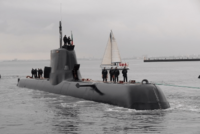 |
Submarine | NRP Tridente (S160) NRP Arpão (S161) |
2010 | Displacement: 2020 t |
Frigates
| Class | Photo | Type | Units | Built | Note |
|---|---|---|---|---|---|
| Bartolomeu Dias class | 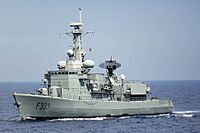 |
Multi purpose frigate | NRP Bartolomeu Dias (F333) NRP D. Francisco de Almeida (F334) |
1994 | Displacement: 3320 t
Length: 122.5 m Speed: 29 kn Range: 5 000 NM Complement: 176 |
| Vasco da Gama class | 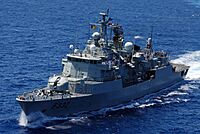 |
Multi purpose frigate | NRP Vasco da Gama (F330) (Being repaired since 2024) NRP Álvares Cabral (F331) NRP Corte-Real (F332) |
1991–1992 | Displacement: 3200 t
Length: 115.90 m Speed: 32 kn Range: 4 000 NM Complement: 180 |
Corvettes
| Class | Photo | Type | Units | Built | Note |
|---|---|---|---|---|---|
| João Coutinho class |  |
Corvette | NRP António Enes (F471) | 1971 | Displacement: 1380 t |
| Baptista de Andrade class | 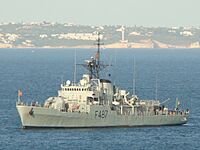 |
Corvette | NRP João Roby (F487) | 1975 | Displacement: 1380 t |
Patrol Vessels
| Class | Photo | Type | Units | Built | Note |
|---|---|---|---|---|---|
| Viana do Castelo class | 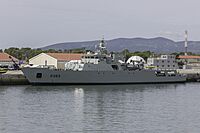 |
Offshore Patrol Boat | NRP Viana do Castelo (P360) NRP Figueira da Foz (P361) NRP Sines (P362) NRP Setúbal (P363) 6 more ordered in 2023 |
2010-2019 | Displacement: 1750 t |
| Tejo class | 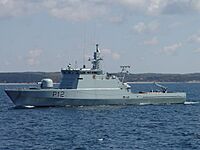 |
Patrol vessel | NRP Tejo (P590) NRP Douro (P591) NRP Mondego (P592) NRP Guadiana (P593) |
1992-1996 | Displacement: 320 t |
| Cacine class | 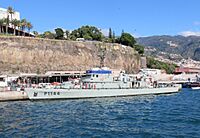 |
Patrol vessel | NRP Zaire (P1146) | 1971 | Displacement: 292 t |
| Argos class | 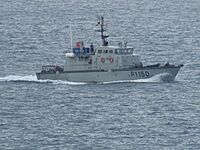 |
Patrol boat | NRP Argos (P1150) NRP Dragão (P1151) NRP Escorpião (P1152) NRP Cassiopeia (P1153) NRP Hidra (P1154) |
1991 | Displacement: 97 t |
| Centauro class | 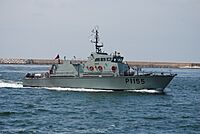 |
Patrol boat | NRP Centauro (P1155) NRP Oríon (P1156) NRP Pégaso (P1157) NRP Sagitário (P1158) |
2000-2001 | Displacement: 94 t |
| Rio Minho class | 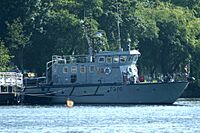 |
Patrol boat | NRP Rio Minho (P370) | 1991 | Displacement: 70 t |
Research Vessels
| Class | Photo | Type | Units | Built | Note |
|---|---|---|---|---|---|
| Dom Carlos I class |  |
Offshore research vessel | NRP Dom Carlos I (A522) NRP Almirante Gago Coutinho (A523) |
1985-1989 | Displacement: 2300 t |
| Andrómeda class | 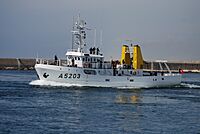 |
Coastal research vessel | NRP Andrómeda (A5203) NRP Auriga (A5205) |
1987-1988 | Displacement: 245 t |
Sailing Vessels
| Class | Photo | Type | Units | Built | Note |
|---|---|---|---|---|---|
| Sagres class | 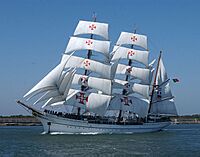 |
Tall ship | NRP Sagres | 1937 | Displacement: 1940 t
Length: 70.4 m Speed: 10.5 kn Range: 5450 NM Complement: 139 |
| Creoula class | 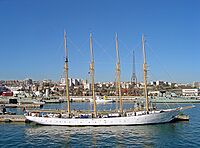 |
Sail training ship | UAM Creoula | 1937 | Displacement: 1300 t |
| Polar class | Sailing vessel | NRP Polar | 1977 | Displacement: 70 t | |
| Zarco class | Sailing vessel | NRP Zarco | 1983 | Displacement: 60 t |
Unmanned Surface Vehicles (USVs)
The Portuguese Navy uses several unmanned surface vehicles (USVs). These are boats that operate without people on board.
- 1 ×
 Unmanned Maritime Vehicle X-801 Macaréu;
Unmanned Maritime Vehicle X-801 Macaréu; - 1 ×
 Unmanned Maritime Vehicle Hidrográfico X-2601;
Unmanned Maritime Vehicle Hidrográfico X-2601; - 1 ×
 Unmanned Maritime Vehicle X-2701;
Unmanned Maritime Vehicle X-2701; - 1 ×
 Unmanned Maritime Vehicle X-2801;
Unmanned Maritime Vehicle X-2801; - 1 ×
 Unmanned Maritime Vehicle Orca;
Unmanned Maritime Vehicle Orca; - 1 ×
 Tecnoveritas UOPV Unmanned Oceanic Patrol Vessel.
Tecnoveritas UOPV Unmanned Oceanic Patrol Vessel.
Future Ships
The Navy plans to get these new types of ships:
- 2 new diesel-electric submarines;
- 1 amphibious transport dock vessel (called Navio Polivalente Logístico or NPL);
- 1 landing platform called NRP D. João II (to operate helicopters and drones);
- 2 replenishment oilers (to replace the Berrio-class tanker);
- 6 more Viana do Castelo-class patrol vessels.
- 8 new Coastal Patrol Vessels (to replace older patrol vessels).
Aircraft
The Navy only has helicopters. It has not had fixed-wing aircraft since 1952. Only the largest Portuguese Navy ships can support aircraft. These include two frigate classes, four patrol vessels, and one tanker.
| Aircraft | Image | Type | Versions | In service |
|---|---|---|---|---|
| Westland Lynx | 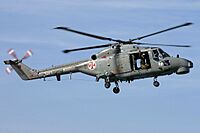 |
Shipborne multipurpose helicopter | Super Lynx Mk.95A | 5 |
Unmanned Aerial Vehicles (UAVs)
The Portuguese Navy also uses Unmanned aerial vehicles (UAVs), also known as drones.
- 6 ×
 Beyond Vision VTOne.
Beyond Vision VTOne. - 6 ×
 Beyond Vision HEIFU.
Beyond Vision HEIFU. - 4 ×
 UAVision UX Spyro;
UAVision UX Spyro; - 2 ×
 UAVision Ogassa OGS42/V;
UAVision Ogassa OGS42/V; - ? ×
 Tekever AR3;
Tekever AR3; - ? ×
 Tekever AR4.
Tekever AR4. - ? ×
 X-1001.
X-1001. - ? ×
 Autel EVO II Dual 640T Enterprise V2
Autel EVO II Dual 640T Enterprise V2
Ranks and Insignia
Officers
| NATO code | OF-10 | OF-9 | OF-8 | OF-7 | OF-6 | OF-5 | OF-4 | OF-3 | OF-2 | OF-1 | OF(D) | Student officer | ||||||||||||||||||||||||
|---|---|---|---|---|---|---|---|---|---|---|---|---|---|---|---|---|---|---|---|---|---|---|---|---|---|---|---|---|---|---|---|---|---|---|---|---|
  |
  |
  |
  |
  |
 |
 |
 |
 |
 |
 |
||||||||||||||||||||||||||
| Almirante da Armada | Almirante | Vice-almirante | Contra-almirante | Comodoro | Capitão de mar e guerra | Capitão de fragata | Capitão-tenente | Primeiro-tenente | Segundo-tenente | Guarda-marinha/ Subtenente |
||||||||||||||||||||||||||
Ratings
| NATO Code | OR-9 | OR-8 | OR-7 | OR-6 | OR-5 | OR-4 | OR-3 | OR-2 | OR-1 | |||||||||||||||||||||||||||
|---|---|---|---|---|---|---|---|---|---|---|---|---|---|---|---|---|---|---|---|---|---|---|---|---|---|---|---|---|---|---|---|---|---|---|---|---|
 |
 |
 |
 |
 |
 |
 |
 |
No insignia | No insignia | |||||||||||||||||||||||||||
| Sargento-mor | Sargento-chefe | Sargento-ajudante | Primeiro-sargento | Segundo-sargento | Subsargento | Cabo-mor | Cabo | Primeiro-marinheiro | Segundo-marinheiro | Primeiro-grumete | Segundo-grumete | |||||||||||||||||||||||||
See also
- List of ships of the Portuguese Navy
- Military history of Portugal
- Fuzileiros, Portuguese Marine Corps
- Special Actions Detachment, naval special operations unit
- Sapper Divers Group, combat divers unit.
- Portuguese Naval Aviation
- Maritime Museum of Lisbon
- Academia de Marinha
- Ship prefix
- Pennant number



